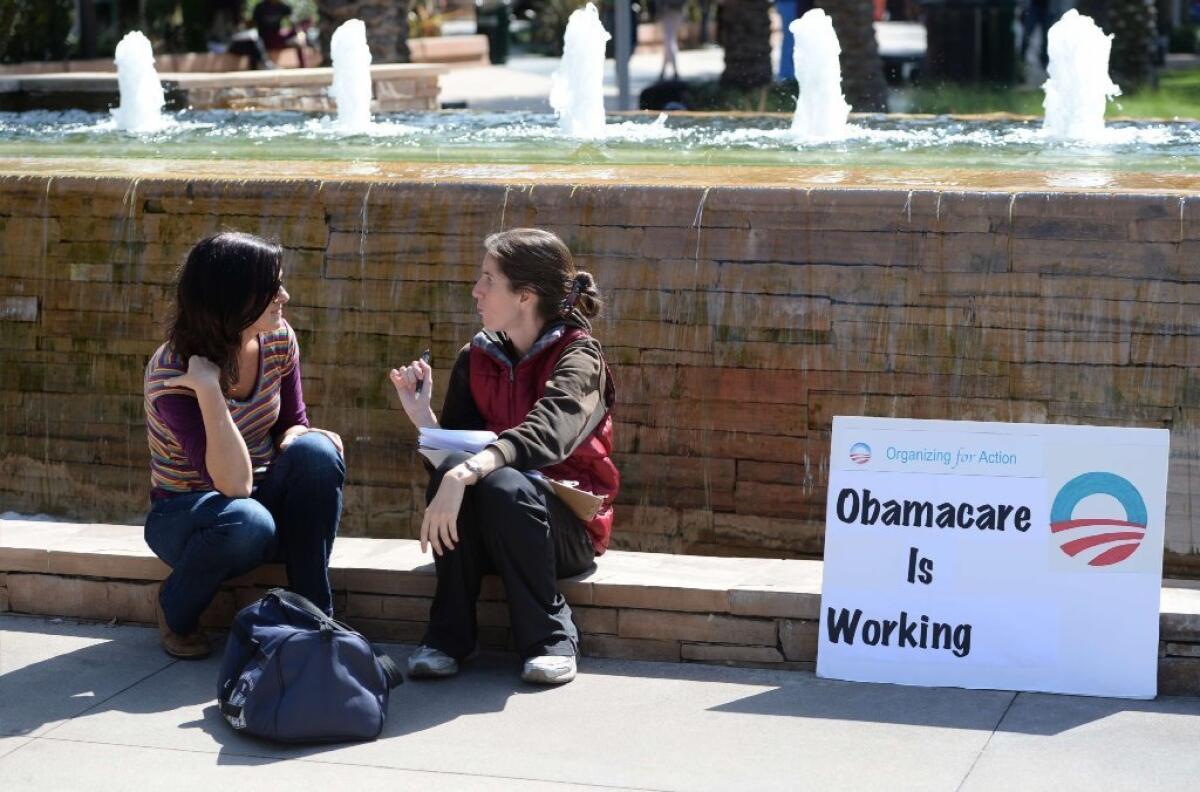Op-Ed: College campuses are fertile ground for promoting Obamacare

- Share via
Much has been made of the need to enroll “young invincibles” under the Affordable Care Act. These are young adults who, according to many, are often uninsured because they think they don’t need insurance. They are also critically important to the success of the ACA. Without their participation, state and national insurance pools in the new marketplaces such as Covered California will be older, sicker and costlier. Insurance premiums will be higher.
Given this challenge, there is very good news from California. A California State University project has enrolled young adults — specifically, students on CSU campuses — at an impressive rate, and offers a model that can be exported to other university systems.
The CSU Health Insurance Education Project, funded by a grant from Covered California, targeted the 450,000-student CSU system, the nation’s largest and probably most diverse four-year university system. Based at Cal State Los Angeles, the project used a peer-to-peer classroom process to educate students at CSU’s 15 largest campuses. Between September 2013 and April 15, 2014, student coordinators gave more than 1,500 class presentations, conducted more than 60 forums, staged 300 enrollment events and facilitated the generation of more than half a million emails.
The results surprised even the most optimistic of project organizers. During the open enrollment period of October 2013-April 15, 2014, the number of uninsured students on the 15 campuses dropped from about 25-30% to just 10% — an unprecedented figure for a young, low-income population. Just as startling was the reduction in the percentage of uninsured Latino students, from more than 40% to 13%. And one-third of students reported that at least one family member signed up for insurance.
Every college and university system will prove unique. But the basic lessons of the CSU project are easy to identify.
First, enrolling young adults is about affordability. A poll taken before open enrollment indicated that more than 80% of uninsured CSU students lacked insurance because they couldn’t afford it. Only 9% reported not needing or wanting it.
Two key provisions altered the affordability equation. The ACA expanded Medicaid eligibility to low-income, childless adults, a sizable segment of the CSU student population. It also provided many other low-income students with generous subsidies for the purchase of private insurance through Covered California. The project’s success makes clear that if insurance is affordable, students will buy it.
Second, those interested in enrolling large numbers of young and healthy individuals should look to colleges and university systems, especially public systems — including community colleges — with large numbers of low-income students. Rather than being among the hardest groups to enroll, these students may be the low-hanging fruit of enrollment projects.
Given their ages and lower incomes, many students in these institutions are uninsured. With systemwide and campus support, they are easy to reach in their classrooms and via email. They mostly trust their peers, faculty and university administrators. They talk to each other and to family members (45% of CSU students polled after open enrollment reported discussing insurance with family members), so reaching one reaches many. They are also tech savvy and not intimidated by online enrollment. Most have applied for financial aid and already have the data they need for application purposes.
Legend has it that Willie Sutton robbed banks because “That’s where the money is.” State university systems may be the banks of young adult insurance enrollment.
Other lessons from the California experience seem less obvious, but may also provide guidance. A focus on injuries and accidents (“stuff happens”) seemed more compelling than a focus on illness. The support of university leadership — in this case, that of CSU Chancellor Timothy White — proved invaluable, opening university doors and shielding the project from any hint of political motivation. The project was never about Democrats and Republicans; it was only about getting affordable healthcare to students. And the project benefited enormously from the aggressive education and enrollment campaign directed by Covered California.
Open enrollment begins again in November. Once again, the new reality of insurance affordability for lower-income young adults and the unique environment of campus communities will offer fertile terrain for those interested in enabling the new system to succeed.
Walter Zelman is the chair of the Department of Public Health at Cal State Los Angeles, and director of the CSU Health Insurance Education Project.
Follow the Opinion section on Twitter @latimesopinion
More to Read
Sign up for Essential California
The most important California stories and recommendations in your inbox every morning.
You may occasionally receive promotional content from the Los Angeles Times.










